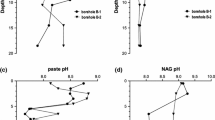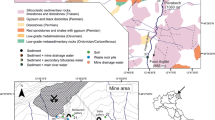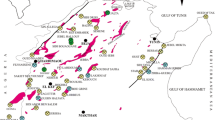Abstract
We studied the mobility of silver, heavy metals and europium in waste from the Las Herrerías mine in Almería (SE Spain). The most abundant primary mineral phases in the mine wastes are hematite, hydrohematite, barite, quartz, muscovite, anorthite, calcite and phillipsite. The minor phase consisted of primary minerals including ankerite, cinnabar, digenite, magnesite, stannite, siderite and jamesonite, and secondary minerals such as glauberite, szomolnokite, thenardite and uklonscovite. The soils show high concentrations of Ag (mean 21.6 mg kg–1), Ba (mean 2.5%), Fe (mean 114,000 mg kg–1), Sb (mean 342.5 mg kg–1), Pb (mean 1,229.8 mg kg–1), Zn (mean 493 mg kg–1), Mn (mean 4,321.1 mg kg–1), Cd (mean 1.2 mg kg–1) and Eu (mean 4.0 mg kg–1). The column experiments showed mobilization of Ag, Al, Ba, Cu, Cd, Eu, Fe, Mn, Ni, Sb, Pb and Zn, and the inverse modelling showed that the dissolution of hematite, hausmannite, pyrolusite and anglesite can largely account for the mobilization of Fe, Mn and Pb in the leaching experiment. The mobility of silver may be caused by the presence of kongsbergite and chlorargyrite in the waste, while the mobility of Eu seems to be determined by Eu(OH)3, which controls the solubility of Eu in the pH–Eh conditions of the experiments. The mineralogy, pH, Eh and geochemical composition of the mine wastes may explain the possible mobilization of heavy metals and metalloids. However, the absence of contaminants in the groundwater may be caused by the carbonate-rich environment of “host-rocks” that limits their mobility.










Similar content being viewed by others
References
Al TA, Martin CJ, Blowes DW (2000) Carbonate-mineral/water interactions in sulfide-rich mine tailings. Geochim Cosmochim Acta 64:3933–3948
Armienta MA, Villaseñor G, Rodríguez R, Ongley LK, Mango H (2001) The role of arsenic-bearing rocks in groundwater pollution at Zimapán Valley, México. Environ Geol 40:571–581
Ashley PM, Lottermoser BG, Collins AJ, Grant CD (2004) Environmental geochemistry of the derelict Webbs Consols mine, New South Wales, Australia. Environ Geol 46:591–604
Blowes DW, Jambor JL (1990) The pore water geochemistry and the mineralogy of the vadose zone of sulfide tailings, Waite Amulet, Quebec Canada. Appl Geochem 5:327–346
Blowes DW, Ptacek CJ (1994) Acid-neutralization mechanisms in inactive mine tailings. In: Jambor JL, Blowes DW (ed) The environmental geochemistry of sulfide-mine wastes. Mineralogical Association of Canada, Short course handbook 22:271–292
Blowes DW, Ptacek CJ, Jurjovec J (2003) Mill tailings: hydrogeology and geochemistry. In: Jambor JL, Blowes DW, Ritchie AIM (ed) Environmental aspects of mine wastes. Mineralogical Association of Canada, Short course series 31:95–116
Blowes DW, Ptacek CJ, Jambor JL, Weisener CG (2004) The geochemistry of acid mine drainage. In: Holland H, Turekian K (ed) Treatise on geochemistry. Environ Geochem 9:149–204
Buckby RA, Otton JK, Johnson CA (2003) Fe-sulphate-rich evaporite mineral precipitates from the Río Tinto, southwest Spain. Mineral Mag 67:263–278
Booth-Rea G, Azañón JM, García-Dueñas V, Augier R (2003) Uppermost tortonian to quaternary depocentre migration related with segmentation of the strike-slip Palomares fault-zone, Vera Basin (SE Spain). C R Geosci 335:751–761
Dold B, Fontboté L (2001) Element cycling and secondary mineralogy in porphyry copper tailings as a function of climate, primary mineralogy and mineral processing. J Geochem Explor 74:3–55
Dold B, Fontboté L (2002) A mineralogical and geochemical study of element mobility in sulfide mine tailings of Fe oxide Cu–Au deposits from the Punta del Cobre belt, nothern Chile. Chem Geol 189:135–163
EPA (1996) Managing environmental problems at inactive and abandoned metal mine sites. EPA/625/R-95/007
Eary LE, Runnels DD, Esposito KJ (2003) Geochemical controls on groundwater composition at the Cripple Creek Mining District, Colorado. Appl Geochem 18:1–24
Harris DL, Lottermoser BG, Duchesne J (2003) Ephemeral acid mine drainage at the Montalbion silver mine, north Queensland. Aust J Earth Sci 50:797–809
Hem JD (1989) Study and interpretation of the chemical characteristics of natural water. Water-supply paper 2254. US Geological Survey, Reston
Herbert RB (1996) Metal retention by iron oxide precipitation from acidic ground water in Dalarna, Sweden. Appl Geochem 11:229–235
Jambor JL, Nordstrom DK, Alpers CN (2000) Metal-sulfate salts from sulfide mineral oxidation. In: Alpers CN, Jambor JL, Nordstrom DK (ed) Sulfate minerals—crystallography, geochemistry, and environmental significance. Mineral Soc Am, Rev Mineral Geochem 40:303–350
Jurjovec J, Ptacek CJ, Blowes DW (2002) Acid neutralization mechanisms and metal release in mine tailings: a laboratory column experiment. Geochim Cosmochim Acta 66:1511–1523
Kelley KD, Seal RR, Schmidt JM, Hoover DB, Klein DP (1996) Sedimentary exhalative Zn–Pb–Ag deposits (model 31 a). Open-file report 95–831. US Geological Survey, Reston
Krupca KM, Senne RJ (2002) Geochemical factors affecting the behaviour of antimony, cobalt, europium, technetium and uranium in Vadose sediments. Pacific Northwest National Laboratory. PNNL-14126
Langmuir D, Chrostowski P, Vigneault B, Chaney R (2005) Issue paper on the environmental chemistry of metals. Risk Assessment Forum, US EPA, Contract 68-C-02–060
López J, Martínez J, Lunar R, López García JA (1993) El rombohorst mineralizado de Las Herrerías: un caso de “doming” e hidrotermalismo submarino mioceno en el SE ibérico. Estudios Geológicos 49:13–19
Lottermoser BG (2003) Mine wastes: characterization, treatment and environmental impacts. Springer, Berlin, pp 277
McGregor RG, Blowes DW, Jambor JL, Robertson WD (1998) The solid-phase controls on the mobility of heavy metals at the Copper Cliff tailings area, Sudbury, Ontario, Canada. J Contam Hydrol 33:247–271
Mahlknecht J, Schneider JF, Merkel BJ, Navarro de León I, Bernasconi SM (2004) Groundwater recharge in a sedimentary basin in semi-arid México. Hydrogeol J 12:511–530
Martínez J, García J, López Ruiz J, Reynolds GA (1992) Discovery of fossil fumaroles in Spain. Econ Geol 87:444–447
Navarro A, Martínez J, Font X, Viladevall M (2000) Modelling of modern mercury vapor transport in an ancient hydrothermal system: environmental and geochemical implications. Appl Geochem 15:281–294
Navarro A, Collado D, Carbonell M, Sánchez JA (2004) Impact of mining activities in a semi-arid environment: Sierra Almagrera district, SE Spain. Environ Geochem Health 26:383–393
Navarro A, Biester H, Mendoza JL, Cardellach E (2006) Mercury speciation and mobilization in contaminated soils of the Valle del Azogue Hg mine (SE, Spain). Environ Geol 49:1089–1101
Parkhurst DL, Appelo CAJ (1999) User’s guide to PHREEQC (version 2)—a computer program for speciation, batch-reaction, one-dimensional transport, and inverse geochemical calculations. Water-resources investigations report 99–4259. US Geological Survey, Reston, pp 326
Ptacek CJ, Blowes WD (2003) Geochemistry of concentrated waters at miner-waste sites. In: Jambor JL, Blowes DW, Ritchie AIM (eds) Environmental aspects of mine wastes. Mineralogical Association of Canada, Short course series 31:239–252
Puigdomenech I (2004) Make equilibrium using sophisticated algorithms (MEDUSA) program. Inorganic Chemistry Department. Royal Institute of Technology, Stockholm. http://web.telia.com/
Ribet I, Ptacek CJ, Blowes DW, Jambor JL (1995) The potential for metal release by reductive dissolution of weathered mine tailings. J Contam Hydrol 17:239–273
Robles-Arenas VM, Rodríguez R, García C, Manteca JI, Candela L (2006) Sulphide-mining impacts in the physical environment: Sierra de Cartagena-La Unión (SE Spain) case study. Environ Geol 51:47–64
Romero FM, Armienta MA, Villaseñor G, González JL (2006) Mineralogical constraints on the mobility of arsenic in tailings from Zimapán, Hidalgo, Mexico. Int J Environ Pollut 26:23–40
Romero FM, Armienta MA, González-Hernández JL (2007) Solid-phase control on the mobility of potentially toxic elements in an abandoned lead/zinc mine tailings impoundment, Taxco, Mexico. Appl Geochem 22:109–127
Rytuba JJ (2003) Mercury from mineral deposits and potential environmental impact. Environ Geol 43:326–338
Schwartz MO (1997) Mercury in zinc deposits: economic geology of a polluting element. Int Geol Rev 39:905–923
Stollenwerk KG (1994) Geochemical interactions between constituents in acidic groundwater and alluvium in an aquifer near Globe, Arizona. Appl Geochem 9:353–369
Wray DS (1998) The impact of unconfined mine tailings and anthropogenic pollution on a semi-arid environment: an initial study of the Rodalquilar mining district, southeast Spain. Environ Geochem Health 20:29–38
Acknowledgments
This study was supported by the Spanish Ministry of Science and Technology (projects REN2003-09247-C04-03 and ENE2006-13267-C05-03) in collaboration with CIEMAT (the Centre for Energy, Environmental and Technological Research). We are grateful to the staff of the Department of Fluid Mechanics (UPC) for carrying out the leaching experiments. The authors are grateful to the anonymous reviewers for their constructive comments.
Author information
Authors and Affiliations
Corresponding author
Rights and permissions
About this article
Cite this article
Navarro, A., Cardellach, E. Mobilization of Ag, heavy metals and Eu from the waste deposit of the Las Herrerias mine (Almería, SE Spain). Environ Geol 56, 1389–1404 (2009). https://doi.org/10.1007/s00254-008-1234-z
Received:
Accepted:
Published:
Issue Date:
DOI: https://doi.org/10.1007/s00254-008-1234-z




